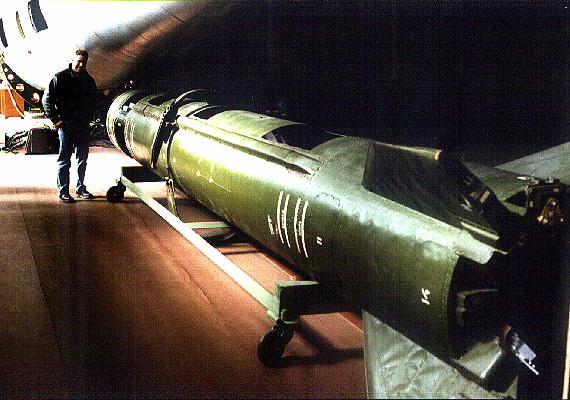
Home - Search - Browse - Alphabetic Index: 0- 1- 2- 3- 4- 5- 6- 7- 8- 9
A- B- C- D- E- F- G- H- I- J- K- L- M- N- O- P- Q- R- S- T- U- V- W- X- Y- Z
R-17 stage

8K14
Credit: © Mark Wade
AKA: 8K14;8K14, SS-1C Scud B, 9K72 Elbrus;9K72 Elbrus;R-17;SS-1C Scud B. Status: Active. Thrust: 93.10 kN (20,930 lbf). Gross mass: 5,385 kg (11,871 lb). Unfuelled mass: 1,645 kg (3,626 lb). Specific impulse: 251 s. Specific impulse sea level: 219 s. Burn time: 95 s. Height: 7.43 m (24.37 ft). Diameter: 0.96 m (3.14 ft). Span: 1.77 m (5.80 ft).
The original R-11 design by Korolev was passed to the Makeyev OKB for further refinement into the R-17. In 1958-1959 Makeyev designed and built the first mock-up of the new missile. But by then the decision was made to devote the bureau to sea-launched missiles, and in 1959 the program was transferred to Votkinsk Machine Building Plant. There design work continued with first launch in 1961 and acceptance into military service in 1964. Later built under license in Iraq and North Korea.
In the 1980s, TsNIIAG (Central Research Institute of Automatics and Hydraulics ) began development of an optronically-guided terrain-comparison and map-matching re-entry vehicle for the R-17. TsNIIAG specialists developed software, an optronic guidance system, onboard equipment for the re-entry vehicle control system, ground-based data gathering equipment, and re-entry vehicle targeting equipment. To ensure the reliability of the guidance system in any weather, and over any terrain, a target databank was developed of more than 10,000 images of the Earth's surface made at different times of day and in different seasons of the year. After a series of ground tests the system's equipment components and software were substantially improved. During hundreds of flights, the system's accuracy and operating reliability in any weather and over any terrain were assessed.
At the final stage of the tests, missiles fitted with target re-entry vehicles were launched. Their point-of-impact error did not exceed a few dozen meters. The work on the R-17 missile equipped with an optronic guidance system was successfully completed, and the missile was subsequently placed in operational service.
Iraq Launched 331 Scud-B missiles at Iran during the Iran-Iraq war, and 189 al-Hussein missiles at Iranian cities during the 1988 "War of the Cities." In the first Iraq War, between January 18 and February 26, 1991, 40 Scuds were launched by Iraq against Israel and 46 against Saudi Arabia. This handful of launches had enormous operational impact on Coalition operations.
Efforts by Coalition air forces to suppress Iraqi launches ran into many problems. Key portions of the target set -- notably the presurveyed launch sites and hiding places used by the mobile launchers -- were not identified before 17 January 1991, and, even in the face of intense efforts to find and destroy them, the mobile launchers proved remarkably elusive and survivable. Although Iraq's average weekly launch rate of modified Scuds during Desert Storm (14.7 launches per week) was lower than it had been during the 1988 "war of the cities," and while launch rates generally declined over the course of the Gulf War, the actual destruction of any Iraqi mobile launchers by fixed-wing Coalition aircraft was impossible to confirm. Coalition aircrews reported destroying around eighty mobile launchers; another score or so were claimed by special operations forces. Most of these reports undoubtedly stemmed from attacks that did destroy objects found in the Scud launch areas. But most, if not all, of the objects involved appear to have been decoys, vehicles such as tanker trucks that had infrared and radar signatures impossible to distinguish from those of mobile launchers and their associated support vehicles, and other objects unfortunate enough to provide "Scud-like" signatures. Over the 43 days of Desert Storm, roughly 1,500 strikes were carried out against targets associated with Iraqi ballistic missile capabilities.
Country: Russia. Engines: Isayev R-17. Launch Vehicles: R-17, Al Hussein, Tamouz. Propellants: Nitric acid/Kerosene.
Back to top of page
Home - Search - Browse - Alphabetic Index: 0- 1- 2- 3- 4- 5- 6- 7- 8- 9
A- B- C- D- E- F- G- H- I- J- K- L- M- N- O- P- Q- R- S- T- U- V- W- X- Y- Z
© 1997-2019 Mark Wade - Contact
© / Conditions for Use